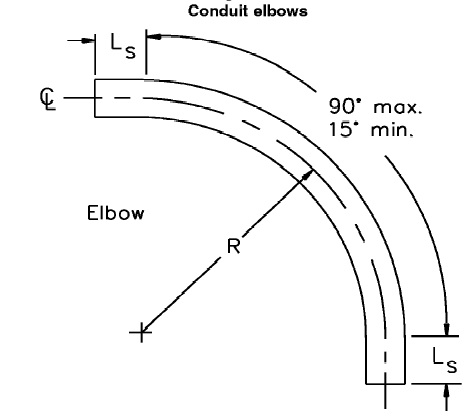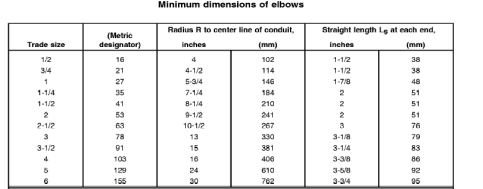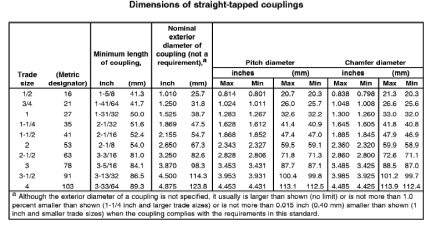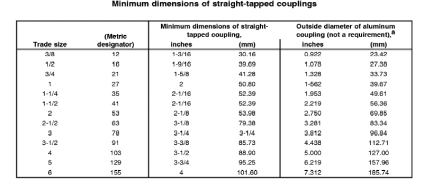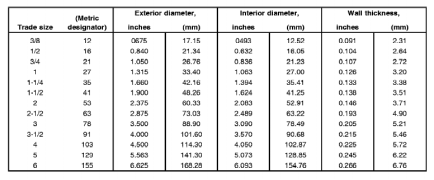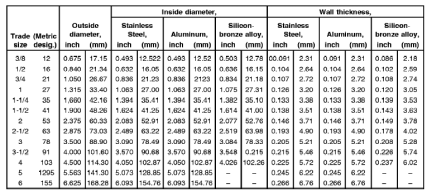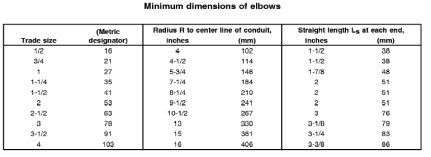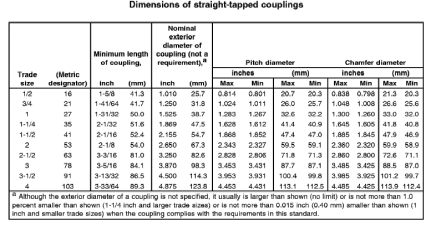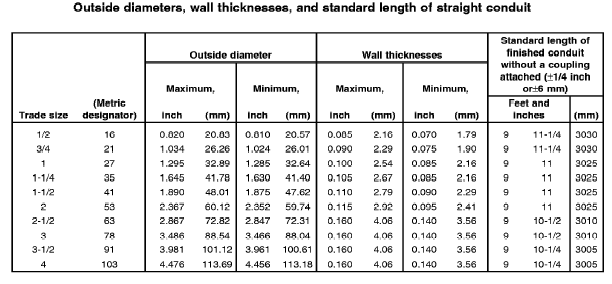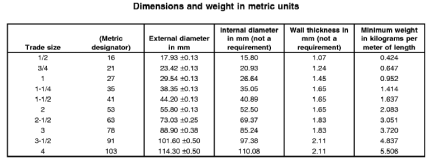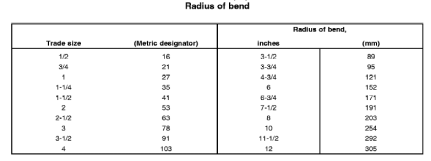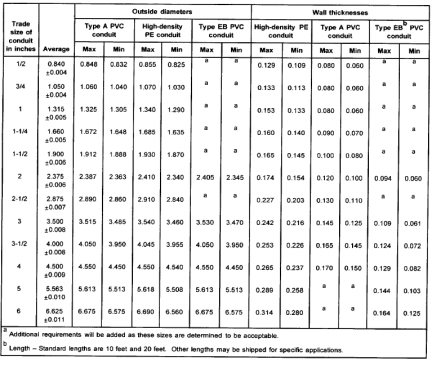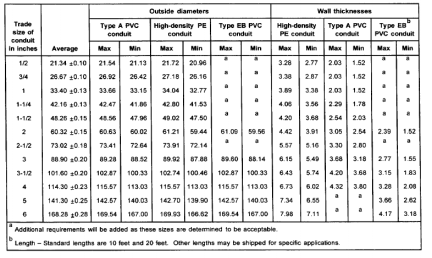1.0 SCOPE
2.0 REFERENCES
3.0 DEFINITIONS
4.0 GENERAL
5.0 ENVIRONMENTAL REQUIREMENTS
6.0 TYPES OF CONDUITS AND TUBING
7.0 INSPECTION
8.0 DOCUMENTATION
9.0 PREPARATION FOR SHIPMENT
1.0 SCOPE
This specification covers the requirements for rigid galvanized steel (RGS) conduit, intermediate metal
conduit (IMC), electrical metallic tubing (EMT) and nonmetallic polyvinyl chlorine (PVC) conduit used as
raceways for electrical wiring for the Jubail United Petrochemical Company’s (United) Olefin Complex
located at Al-Jubail, Kingdom of Saudi Arabia.
2.0 REFERENCES
Reference is made in this specification to the following documents. The latest edition, amendments, and
supplements to these documents shall apply unless otherwise indicated.
2.1 SABIC Engineering Standards (SES)
E23-S01
Conduits Metallic, PVC Coated and Nonmetallic
Z01-G04
Measurements of units for use in SABIC projects
Z01-G03
Metrification
2.2 United Engineering Standard (UES)
00-E-0033
Conduit System Installation Requirements
2.3 American National Standards Institute (ANSI)
ANSI Std. C80.1 Rigid Steel Conduit, Zinc Coated
2.4 American Society For Testing & Material (ASTM)
D149
Std. Test Method for Dielectric Break Down Strength for Solid Electric I
Insulating Material @ Communication Power Frequencies
D638
Std. Test Method for Tensile Properties of Plastic
D1790
Std. Test Method for Brittleness Temperature of Plastic Sheeting by Impact.
D2240
Std. Test Method for Rubber Property –Duro Hardness
2.5
National Electrical Manufacturers Association (NEMA)
Std. RN1
Polyvinyl-Chlorine (PVC) Externally Coated Rigid Galvanized Steel (RGS)
Conduit and Intermediate Metal Conduit (IMC)
2.6
National Fire Protection Association (NFPA)
NFPA 70
National Electrical Code (NEC)
2.7 Underwriters’ Laboratory (UL)
Std. 6
Electrical Rigid Metal Conduit-Steel
Std.6A
Electrical Rigid Metal Conduit-Aluminum, Bronze, and Stainless
Std. 651A
Types EB and A Rigid PVC Conduit and HDPE Conduit
Std. 797
Electrical Metallic Tubing
Std. 1242
Intermediate Metal Conduit
3.0 DEFINITIONS
3.1 SABIC
SABIC or its duly elected representative(s)
3.2 United
Jubail United Petrochemical Company
3.3 Threaded coupling A threaded coupling for a metal conduit is an internally threaded cylinder for
connecting two sections of metal conduit.
3.4
Elbow and bend An elbow or bend is a curved section of metal conduit threaded on each end.
3.5
Nipple
A nipple is a straight section of rigid conduit threaded on each end.
4.0 GENERAL
4.1 Any conflict(s) between this specification, SES, UES and other industry standards, engineering
drawings, and contract documents shall be resolved at the discretion of United.
4.2 All drawings and documents shall use SI units of measure in accordance with SES Z01-G04 and
Z01- G03.
4.3 Communications between United and any parties involved in the design, construction, testing and
shipment of all conduits covered by this specification shall be in English language.
5.0 ENVIRONMENTAL REQUIREMENTS
5.1
Indoor Conditions:
Temperature Range:
10°C to 40°C.
Relative Humidity:
0 to 50 percent.
5.2 Outdoor Conditions:
Ambient Temperature Range:
1°C to 50°C
Relative Humidity:
1 to 100 percent
Metallic surface temperatures reaching 75°C due to solar radiation.
Corrosive desert atmosphere with blowing sand and dust.
5.3
Storage/Transport Conditions:
Ambient Temperature:
1°C to 70°C.
Relative Humidity Range:
1 to100 percent
5.4
Seismic Condition:
Earthquake Zone 1, UBC unless noted otherwise.
5.5 Altitude:
Sea Level
6.0 TYPES OF CONDUITS AND TUBING
6.1 Rigid Metal Conduit
The rigid metal conduits covered by this section of this specification are hot dip rigid galvanized
steel (RGS) conduit and PVC coated rigid galvanized steel conduits. The conduit shall be
furnished in nominal 3.05m (10ft.) lengths, threaded on each end with one coupling attached
unless otherwise stated in this specification. The application of these conduit systems is for indoor
and outdoor use in accordance with the applicable requirements of NFPA 70 (NEC) and UES 00-
E-0033.
6.1.1 RGS conduit or PVC coated RGS conduit, metal nipples, elbows, and couplings shall be
manufactured in accordance with the requirements of either UL standard 6 or UL
standard 6A. Each component of the conduit system shall be constructed of the same
metal material as the conduit.
6.1.2 For the purpose of understanding the dimensions of elbows see Fig #1.
6.1.3 The minimum dimensions for RGS conduit elbows shall be per UL standard 6 indicated
in Table 1 below:
6.1.4 The minimum dimensions for RGS conduit couplings shall be per UL standard 6
indicated in Table 2 below:
6.1.5 The minimum dimensions for aluminum conduit elbow shall be per UL standard 6A
indicated in Table 3 below:
6.1.6 The minimum dimensions for aluminum conduit couplings shall be per UL standard 6A
indicated in Table 4 below:
6.1.7 The conduit shall have a circular cross section sufficiently accurate to allow the uniform
cutting of threads per the requirements of standards UL 6 and UL 6A.
6.1.8 Trade sizes for rigid galvanized steel conduit shall be as noted in Table 5 below.
6.1.9 The wall thickness, internal diameter and the external diameter of rigid galvanized steel
conduit (RGS) shall be per UL standard 6 indicated in Table 5 below:
Dimensions of Conduit
Table 5
6.1.10 The nominal wall thickness, internal diameter and the external diameter of rigid metal
conduit, such as aluminum, shall be per UL 6A as noted in Table 6.
Dimensions of Rigid Metal Conduit
6.1.11 The galvanized coating on RGS conduit shall be a minimum thickness of 0.02mm
(0.0008 inch) per ANSI standard C80.1. The inside surface coating shall be free of burrs
or other injurious defects.
6.1.12 PVC coated conduit shall be coated internally and externally. The PVC external coating
nominal thickness on conduit shall be 1.02mm (0.04 inch) and the internal coating
nominal thickness shall be 0.18mm (0.007 inch) thick, per NEMA standard RN 1.
6.2
Intermediate Metal Conduit (IMC)
6.2.1 Intermediate metal conduit is a thin walled rigid metal conduit with its uses as noted in
Section 345 of NFPA 70 and in UES 00-E-0033.
6.2.2 IMC conduit, nipples, elbows, and couplings shall be manufactured in accordance with
UL standard 1242.
6.2.3 Elbow bend shall not be greater than 90 degrees nor less than 15 degrees. The minimum
dimensions for IMC elbows shall be per Table 7 below:
6.2.4 The length of couplings shall be per UL standard 1242 as indicated in Table 8 below:
6.2.5 IMC conduit shall have a circular cross section sufficiently accurate to allow the uniform
cutting of threads as per UL standard 1242.
6.2.6 The available trade sizes for IMC are as noted in the table 9 below.
6.2.7 The wall thickness, internal diameter and the external diameter of straight runs of IMC
conduit shall be per UL 1242 as noted in Table 9 below:
6.3
Electrical Metallic Tubing (EMT)
6.3.1 Electrical metallic tubing (EMT) is a thin walled metallic tubing with its uses as noted in
Section 348 of NFPA 70 and in UES 00-E-0033. EMT conduit shall be constructed in
accordance with the requirements of UL standard 797.
6.3.2 EMT shall be of steel, or aluminum-base alloy. The tubing shall be straight and shall
have a circular cross-section. The walls shall be of uniform thickness through its full
length.
6.3.3 EMT conduit shall not be threaded. Sleeved coupling and fittings provided with set
screws shall be the means used for connecting each section of tubing.
6.3.4 The maximum length of EMT shall be per UL standard 797 as noted in Table 10 below:
6.3.5 The nominal trade size, external diameter, internal diameter and the wall thickness in
inches shall be per UL standard 797 as noted in Table 11 below:
6.3.6 The trade size, external diameter, internal diameter and the wall thickness in mm shall be
per UL 797 as noted in Table 12 below:
6.3.7 The nominal inner radius of bends shall be per UL 797 as noted in Table 13 below:
6.4 PolyVinyl Chlorine (PVC) Conduit
6.4.1 PVC conduit is a rigid non-metallic conduit with its uses as noted in Section 347 of
NFPA 70. PVC conduit shall be constructed in strict accordance with UL 651 A. PVC
conduit shall be used only in underground duct banks.
6.4.2 Limits on the wall thickness and outside diameter of PVC and polyethylene (PE) conduits
shall be per UL651A and are specified in inches in Table 14 and in millimeters in Table
15 below.
Table 14 below shows the outside diameter and wall thickness of PVC and high–density PE conduit in
INCHES:
Table 15 below shows the limits on outside diameters and wall thickness of PVC and high–density PE
conduit in MILLIMETERS:
6.5 PVC Binding Properties
NEMA standard RN 1 provides the properties of PVC coating for conduit which shall be adhered
to as noted in Table 16 below:
7.0
INSPECTION
Conduit shall be visually inspected to insure that it is straight and not deformed. Conduit and fittings shall
be visually inspected for surface defects such as cracks, flakes, rough edges, and internal surface
obstructions, which would cause damage to cable to be installed. Any conduit or fittings that are found not
in conformance with the requirements of this specification shall be rejected and returned to the supplier at
no additional cost to United.
8.0 DOCUMENTATION
All drawings, data, installation, operation and maintenance manuals shall be provided as outlined in the
Request for Quotation (RFQ) and/or Purchase Order.
9.0 PREPARATION FOR SHIPMENT
Preparation for shipment of the equipment and components shall be as outlined in the Request for
Quotation (RFQ) and/or Purchase Order.
